How to Install Windows 7 on Windows 8
Method 1 of 3:
Installing Windows 7 Alongside Windows 8
-
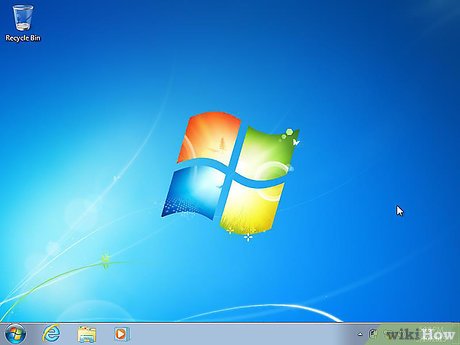 Start with Windows 7. Windows 8 includes a new boot manager, which is the software your computer uses to determine which operating system to load. This means that if you want to dual-boot Windows 7 and Windows 8, Windows 8 needs to be installed last, or Windows 8 won't be able to boot.
Start with Windows 7. Windows 8 includes a new boot manager, which is the software your computer uses to determine which operating system to load. This means that if you want to dual-boot Windows 7 and Windows 8, Windows 8 needs to be installed last, or Windows 8 won't be able to boot. -
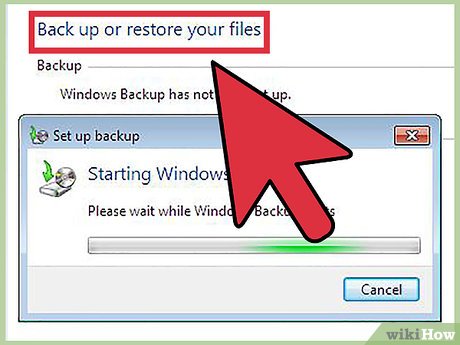 Backup any important data. Before installing your two operating systems, you'll want to make sure that any important data has been safely backed up to a secure storage location. Installing operating systems will wipe anything that's currently on the disc. Click here for detailed instructions on backing up your data.
Backup any important data. Before installing your two operating systems, you'll want to make sure that any important data has been safely backed up to a secure storage location. Installing operating systems will wipe anything that's currently on the disc. Click here for detailed instructions on backing up your data. -
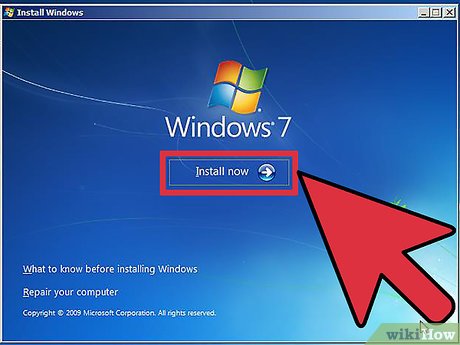 Start the Windows 7 installation. Insert the Windows 7 DVD into your computer and boot from it to begin the Windows 7 installation process. Select "Custom (advanced)" as your installation type and follow the prompts until you get to the "Where do you want to install Windows?" screen.
Start the Windows 7 installation. Insert the Windows 7 DVD into your computer and boot from it to begin the Windows 7 installation process. Select "Custom (advanced)" as your installation type and follow the prompts until you get to the "Where do you want to install Windows?" screen.- Click here for details on starting the installation process.
-
 Create two different partitions. The "Where do you want to install Windows?" screen allows you to create and format partitions on your hard drive. A partition is a segment of your drive that is formatted separately and given its own drive letter. Each partition acts like a separate hard drive. Note: If you have two separate physical drives, you don't have to worry about partitioning, as you can install each operating system to its own drive.
Create two different partitions. The "Where do you want to install Windows?" screen allows you to create and format partitions on your hard drive. A partition is a segment of your drive that is formatted separately and given its own drive letter. Each partition acts like a separate hard drive. Note: If you have two separate physical drives, you don't have to worry about partitioning, as you can install each operating system to its own drive.- Click the "Drive options (advanced)" option.
- Delete all of your existing partitions. All of the space on your drive will be combined into one chunk of "Unallocated space".
- Select the unallocated space and click "New". Set how large you want the Windows 7 drive to be. Repeat this to create the partition for Windows 8 (you'll use it later but creating it now makes things easier down the road). Make sure each partition is at least 25 GB, more if you plan on installing a lot of programs.
-
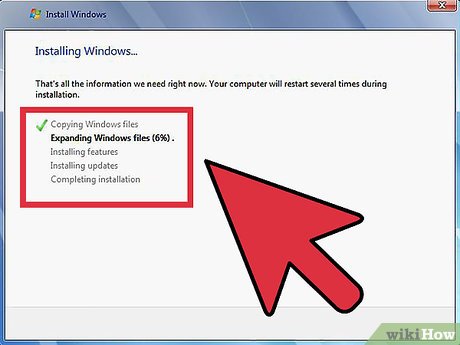 Proceed installing Windows 7 on the first partition you created. Follow the guide linked above to finish the installation as normal.
Proceed installing Windows 7 on the first partition you created. Follow the guide linked above to finish the installation as normal. -
 Insert your Windows 8 disc and install it after installing Windows 7. Once Windows 7 has been successfully installed on the first partition, you can go ahead and install Windows 8 on the second partition.
Insert your Windows 8 disc and install it after installing Windows 7. Once Windows 7 has been successfully installed on the first partition, you can go ahead and install Windows 8 on the second partition.- Click here for detailed instructions on installing Windows 8.
- Select "Custom: Install Windows only (advanced)" for the installation type.
- Make sure you select the correct partition in the "Where do you want to install Windows?" screen. The one with Windows 7 installed on it will be marked "System" in the "Type" column.
-
 Boot into Windows 8. After installing Windows 8, it will be set as your primary operating system. It will start automatically if you don't select an operating system from the boot manager.
Boot into Windows 8. After installing Windows 8, it will be set as your primary operating system. It will start automatically if you don't select an operating system from the boot manager. -
 Change your boot settings. If you'd prefer to automatically boot into Windows 7, or want to adjust the time that you have to select your option when the computer starts up, you can make changes to your computers boot settings from within Windows 8.[1]
Change your boot settings. If you'd prefer to automatically boot into Windows 7, or want to adjust the time that you have to select your option when the computer starts up, you can make changes to your computers boot settings from within Windows 8.[1]- Press ⊞ Win+R, type msconfig, and press ↵ Enter
- Click the Boot tab.
- Select the operating system you want to automatically boot to and click Set as default.
- Change the time you have to select your operating system when the computer starts by changing the "Timeout" value.
- Click Apply when you are satisfied with your changes.
Method 2 of 3:
Using a Virtual Machine
-
 Download and install Oracle VM VirtualBox. This program allows you to create a virtual hard drive on your computer which you can then install Windows 7 on. You can then boot up Windows 7 in a window while you're running Windows 8.
Download and install Oracle VM VirtualBox. This program allows you to create a virtual hard drive on your computer which you can then install Windows 7 on. You can then boot up Windows 7 in a window while you're running Windows 8.- Most users can leave the installation options at their defaults. You can download from Oracle VM VirtualBox virtualbox.org/
- Oracle VM VirtualBox is a free program, though there are other options available as well.
- This method is great for getting quick access to Windows 7 without having to reboot, but graphic-intensive programs such as games will not perform well on the virtual machine.
-
 Ensure you have enough free space to install Windows 7. When using VirtualBox, you'll be creating a virtual drive out of the free space on your hard drive. You'll want to be able to dedicate at least enough space for the operating system to install and run properly (about 20 GB), more if you want to be able to install programs.
Ensure you have enough free space to install Windows 7. When using VirtualBox, you'll be creating a virtual drive out of the free space on your hard drive. You'll want to be able to dedicate at least enough space for the operating system to install and run properly (about 20 GB), more if you want to be able to install programs.- Make sure that you are leaving enough space for Windows 8 programs and files as well.
-
 Click the "New" button at the top of the VirtualBox window. This will start the process for installing a new virtual operating system.
Click the "New" button at the top of the VirtualBox window. This will start the process for installing a new virtual operating system. -
 Enter in the basic information for your virtual machine. You will be prompted to give the machine a name and select the operating system.
Enter in the basic information for your virtual machine. You will be prompted to give the machine a name and select the operating system.- You can name the virtual machine anything, though simply naming it "Windows 7" might be the most convenient.
- Select "Microsoft Windows" as the type.
- Select "Windows 7 (32 bit)" or "Windows 7 (64 bit)" depending on the version you are installing. Your Windows installation disc will say which version it is. You cannot run a virtual 64-bit machine on a 32-bit computer. Click here for details on determine what version computer you have.
-
 Set the amount of memory (RAM) you want to dedicate to the machine. You can only dedicate RAM from the physical amount installed on your computer. Windows 7 requires 1 GB (1024 MB) of RAM, and it is recommended that you allocate about half of your available RAM for good performance.
Set the amount of memory (RAM) you want to dedicate to the machine. You can only dedicate RAM from the physical amount installed on your computer. Windows 7 requires 1 GB (1024 MB) of RAM, and it is recommended that you allocate about half of your available RAM for good performance.- Don't allocate all of your RAM, or your regular operating system will encounter errors when the virtual machine is running.
-
 Select "Create a virtual hard drive now". This will start the process for creating a new virtual drive to install Windows 7 on.
Select "Create a virtual hard drive now". This will start the process for creating a new virtual drive to install Windows 7 on. -
 Select "VDI" as the hard drive file type. If you know you'll need the hard drive image file for other programs, you can choose the appropriate file type, but most users can leave "VDI" selected.
Select "VDI" as the hard drive file type. If you know you'll need the hard drive image file for other programs, you can choose the appropriate file type, but most users can leave "VDI" selected. -
 Select between a "Dynamically allocated" or "Fixed size" drive. The choice is up to you. A fixed size drive will offer improved performance, but the dynamic drive may take up less space on the computer.
Select between a "Dynamically allocated" or "Fixed size" drive. The choice is up to you. A fixed size drive will offer improved performance, but the dynamic drive may take up less space on the computer.- If you select "Dynamic", you'll still need to set a maximum size.
-
 Select a location for the virtual drive. Click the Folder icon next to the drive name to select where you want it saved. This is especially useful if you want to store your virtual machines on a storage drive.
Select a location for the virtual drive. Click the Folder icon next to the drive name to select where you want it saved. This is especially useful if you want to store your virtual machines on a storage drive. -
 Set the drive size or limit. Beneath the virtual drive name, you'll see a slider that allows you to set the size or limit. Make sure that you include at least enough space to comfortably install Windows 7 (20 GB).
Set the drive size or limit. Beneath the virtual drive name, you'll see a slider that allows you to set the size or limit. Make sure that you include at least enough space to comfortably install Windows 7 (20 GB). -
 Wait for the drive to be created. This may take a while, especially if you are creating a large fixed drive.
Wait for the drive to be created. This may take a while, especially if you are creating a large fixed drive. -
 Download the Windows 7 ISO file, or insert your installation disc in your DVD drive. You can install Windows 7 from an ISO file just like you would an installation DVD. Both require a valid Product Key.
Download the Windows 7 ISO file, or insert your installation disc in your DVD drive. You can install Windows 7 from an ISO file just like you would an installation DVD. Both require a valid Product Key.- If you purchased Windows 7 from the Microsoft website, you'll most likely be using an ISO.
-
 Select your new virtual machine in the VirtualBox main window. You'll see the details of the system in the main frame.
Select your new virtual machine in the VirtualBox main window. You'll see the details of the system in the main frame. -
 Click the "Storage" header. This will open the Storage menu, where you can select your installation disc or ISO.
Click the "Storage" header. This will open the Storage menu, where you can select your installation disc or ISO. -
 Select the virtual CD/DVD drive. it will likely say "Empty". You will see the Attributes and Information on the right.
Select the virtual CD/DVD drive. it will likely say "Empty". You will see the Attributes and Information on the right. -
 Click the small Disc button in the Attributes section. Select how you would like to load the installation disc.
Click the small Disc button in the Attributes section. Select how you would like to load the installation disc.- If you have an installation disc inserted in your computer, select the appropriate "Host Drive". The term "Host" refers to your physical computer.
- If you are installing from an ISO, select "Choose a virtual CD/DVD disk file". This will open a file browser, allowing you to find and select your ISO file.
-
 Start the virtual machine. Once you've selected your installation media, you can start the virtual machine and begin installing Windows 7. Select your Windows 7 virtual machine and click "Start". A new window will open mimicking the display of another computer.
Start the virtual machine. Once you've selected your installation media, you can start the virtual machine and begin installing Windows 7. Select your Windows 7 virtual machine and click "Start". A new window will open mimicking the display of another computer. -
 Press a key when prompted to start the installation. You will see a message indicating when to press any key on your keyboard.
Press a key when prompted to start the installation. You will see a message indicating when to press any key on your keyboard. -
 Follow the prompts to install Windows 7. Installation will proceed from this point just as if you were installing it on a physical computer. Click here for detailed instructions on completing the Windows 7 installation.
Follow the prompts to install Windows 7. Installation will proceed from this point just as if you were installing it on a physical computer. Click here for detailed instructions on completing the Windows 7 installation. -
 Start the virtual machine. Once you have Windows 7 installed, you can start it at any time by opening VirtualBox, selecting your Windows 7 virtual machine, and clicking Start. You can also right-click on the virtual machine in VirtualBox to create a shortcut on your desktop which allows you to start the machine with a single click.[2]
Start the virtual machine. Once you have Windows 7 installed, you can start it at any time by opening VirtualBox, selecting your Windows 7 virtual machine, and clicking Start. You can also right-click on the virtual machine in VirtualBox to create a shortcut on your desktop which allows you to start the machine with a single click.[2]
Method 3 of 3:
Replacing Windows 8 with Windows 7
-
 Back up any important files. Replacing Windows 8 with Windows 7 will erase all of the data on your hard drive, so make sure you have everything you need saved backed up to a secure location. Click here for detailed instructions on quickly backing up your necessary files.
Back up any important files. Replacing Windows 8 with Windows 7 will erase all of the data on your hard drive, so make sure you have everything you need saved backed up to a secure location. Click here for detailed instructions on quickly backing up your necessary files. -
 Insert your Windows 7 installation disc. If you only have an ISO file, you will need to burn it to a DVD or create a bootable USB drive.
Insert your Windows 7 installation disc. If you only have an ISO file, you will need to burn it to a DVD or create a bootable USB drive. -
 Boot your computer from your installation drive. You can set your boot order in your computer's BIOS menu, which can be accessed as the computer boots up by pressing the correct key. Typical keys include F2, F10, F11, and Del.
Boot your computer from your installation drive. You can set your boot order in your computer's BIOS menu, which can be accessed as the computer boots up by pressing the correct key. Typical keys include F2, F10, F11, and Del.- Navigate to the BOOT menu to change the order of your boot drives. Make sure that your installation drive is set to be the first boot device.
-
 Save your changes and reboot. You will be prompted to press a key to begin the setup process.
Save your changes and reboot. You will be prompted to press a key to begin the setup process. -
 Follow the prompts to start the installation. You will be asked to select language and input settings, as well as agree to the terms and license.
Follow the prompts to start the installation. You will be asked to select language and input settings, as well as agree to the terms and license. -
 Select your Windows 8 partition when asked where you want to install. Your Windows 7 partition will be marked as "System" in the "Type" column.
Select your Windows 8 partition when asked where you want to install. Your Windows 7 partition will be marked as "System" in the "Type" column.- Installing over your Windows 8 partition will erase all of the data on it.
-
 Finish the installation procedure. You can follow the prompts to finish the installation. Click here for detailed instructions on completing the Windows 7 installation.
Finish the installation procedure. You can follow the prompts to finish the installation. Click here for detailed instructions on completing the Windows 7 installation.
5 ★ | 1 Vote
You should read it
- How to Clear All Files from a Computer Running Windows XP
- How to Format a PC
- How to install and use SSDs for laptops
- How to Format the C Drive With Windows 7
- Create a Windows XP installation disc for laptops using SATA hard drives
- How to install Windows 10, 7 from hard drive without USB Boot
- Parallel installation of Windows 10 with Windows 7 or 8
- How to check Windows computer using SSD or HDD?
May be interested
- Instructions to install Windows by USB, create USB boot, USB install Windows
 creating usb boot, usb install windows is very necessary when your computer does not have a damaged cd / dvd drive or dvd drive is unusable. all you need is a 4gb usb and windows installation iso file ...
creating usb boot, usb install windows is very necessary when your computer does not have a damaged cd / dvd drive or dvd drive is unusable. all you need is a 4gb usb and windows installation iso file ... - Install Windows 8 on the new partition
 here's how to download and install windows 8 developer preview build on a new partition on the hard drive.
here's how to download and install windows 8 developer preview build on a new partition on the hard drive. - Free tool to help you install Windows 11 without TPM, bypassing hardware requirements
 windows 11 has some pretty strict requirements for security as well as minimal hardware. to install the new microsoft operating system, your computer must have tpm 2.0, secure boot and the cpu must be officially supported from microsoft.
windows 11 has some pretty strict requirements for security as well as minimal hardware. to install the new microsoft operating system, your computer must have tpm 2.0, secure boot and the cpu must be officially supported from microsoft. - 8 ways to fix the problem of not being able to install Firefox on Windows
 some windows users find it difficult to install firefox. when trying to install, they get the following error message: hmm. for some reason, we could not install firefox. choose ok to start over.
some windows users find it difficult to install firefox. when trying to install, they get the following error message: hmm. for some reason, we could not install firefox. choose ok to start over. - Install Win 7 from your hard drive, no need for USB, install Win disk
 installing win 7 from your hard drive is a way to install the operating system directly on your hard drive without a usb drive or a win drive. useful when you do not know how to create a usb drive to install win or drive failure, usb connection port.
installing win 7 from your hard drive is a way to install the operating system directly on your hard drive without a usb drive or a win drive. useful when you do not know how to create a usb drive to install win or drive failure, usb connection port. - How to install Microsoft NET Framework 4.5 full for Windows 7, 8 with Windows Update
 in the article below, tipsmake.com will guide you on the necessary steps to install net framework 4.5 on windows 7 platform. technically, there are many ways to install the .net framework platform on the operating system. windows such as downloading offline files, installing via windows features ...
in the article below, tipsmake.com will guide you on the necessary steps to install net framework 4.5 on windows 7 platform. technically, there are many ways to install the .net framework platform on the operating system. windows such as downloading offline files, installing via windows features ... - How to Install Windows 8.1
 this wikihow teaches you how to install windows 8.1 on your pc. if you're currently using windows 8, you'll just need to run some quick updates to get 8.1. if you just want to install windows 8.1 over a different windows version (from...
this wikihow teaches you how to install windows 8.1 on your pc. if you're currently using windows 8, you'll just need to run some quick updates to get 8.1. if you just want to install windows 8.1 over a different windows version (from... - How to install Windows 7 from USB
 we will guide you how to install win 7 with usb from a to z, start by creating a usb flash drive for installing windows 7 and installing windows 7 operating system from usb.
we will guide you how to install win 7 with usb from a to z, start by creating a usb flash drive for installing windows 7 and installing windows 7 operating system from usb. - How to install Windows 11 on Raspberry Pi 4
 you will learn how to bypass microsoft's strict requirements and install windows 11 on raspberry pi 4.
you will learn how to bypass microsoft's strict requirements and install windows 11 on raspberry pi 4. - Steps to install Windows 7 on Mac using Boot Camp
 windows is the operating system used quite popular and widely around the world. if you've just used a mac and you want to use or experience some windows applications on your mac, you can install windows and mac os x operating systems in parallel with bootcamp.
windows is the operating system used quite popular and widely around the world. if you've just used a mac and you want to use or experience some windows applications on your mac, you can install windows and mac os x operating systems in parallel with bootcamp.





















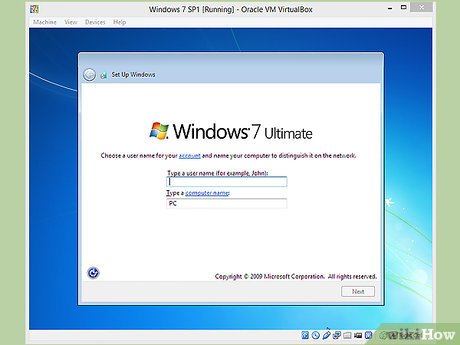


















 How to Make an Audio CD With Windows 7
How to Make an Audio CD With Windows 7 How to Adjust the Master Volume in Windows 7
How to Adjust the Master Volume in Windows 7 How to Create a Recovery Disc in Windows 7
How to Create a Recovery Disc in Windows 7 How to Downgrade Windows 8 to Windows 7
How to Downgrade Windows 8 to Windows 7 How to Install Tomcat on Windows 7
How to Install Tomcat on Windows 7